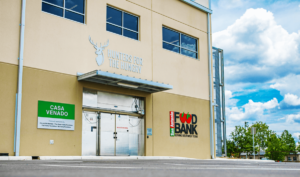When you read the word blockchain, a technology initially used for cryptocurrency like Bitcoin, a question that might come to mind might be: “What does this have to do with my food bank?”
While it’s true that blockchain was initially used for the financial sector, advocates for the technology tout its potential for all types of businesses, including one that is crucial for any successful food bank— the supply chain.
“I think blockchain is going to potentially disrupt many things in the nonprofit sector, and hunger is a really good use case,” said Scott Ferry, Founder of Web Solutions on Call and a former information technology executive at Feeding America. “There’s a timestamp, it’s immutable, and it’s auditable. With those three characteristics, suddenly, you have a truth in the supply chain of regular business operations that has never before been easier to expose.”
These three tenets— timestamps, immutable, and auditable— allow blockchain to build trust and transparency into any transaction-based business, including food banking. And while trust and transparency sound great, what does it all mean?
At its core, blockchain is a type of distributed public ledger or a peer-to-peer database. There is no central administrator, and data is shared among members of the blockchain network.
Data like the details of a transaction, a unique identifier code, and a timestamp is stored in a block. Data can be anything, including an online monetary donation, food delivery, or operational cost. Each block is added to a network chain in chronological order using the identifier code to connect a block to the previous block in the chain.
This information is considered secure because, unlike a written ledger, a blockchain is decentralized and stored across various networks, meaning no one person or entity has complete control. Each time a block is added or changed to a blockchain, the majority of network users must agree to the change, and only then is the network updated. Changing one block in the middle of the chain means changing every subsequent block and getting those changes approved by the network, making any change unlikely and the data immutable. This transparency is what builds trust into an operation.

Think of a transaction in a blockchain as a person traveling with a passport. A passport is a physical record of all the places a person travels. Each new country visited requires a new stamp (block) in your passport (blockchain.) A stamp is difficult to alter once it is in a book. You could rip the page out or try to edit it yourself, but more than likely, someone will be able to tell that something changed in the passport book and will flag the anomaly. This is what makes a passport a trustworthy document of identification. A blockchain is the same type of immutable recordkeeper.
If blockchain still feels like an abstract concept, that’s ok. It has yet to make an impact on the emergency food network in any meaningful way. But if and when it does, the benefits are potentially threefold.
Supply Chain Transparency: Food banks are a complex and life-saving supply chain. Food donations come in from government programs, nonprofits, corporate backers, and even individual donors. Food banks have to receive food from all these different sources and redistribute it to food pantries and families in need. Tracking specific shipments can get complicated.
Remember that passport? Think of a food shipment as the person who owns that passport book. In a blockchain, each delivery step initiates a timestamped record tracking shipments from a warehouse to a customer’s table, documenting each time the shipment changes hands. Upon delivery, you can look back on the journey to see where the shipment went and to whom.
If something goes wrong — like the delivery of spoiled food — you would be able to backtrack through the blockchain to see who handled the shipment in the supply chain and immediately begin rectifying the problem. Perhaps the food spent too much time on a truck, or the refrigeration broke in a food pantry. The data provided by blockchain can identify the issue, strengthening the supply chain to better serve the customers who rely on it.
Financial Transparency: Suppose a donor wants to know what their $100 donation contributes to at a food bank? Usually, they assume it goes to purchasing food, but it could also go to logistical, operational, or labor costs. These are vital to keeping a food bank running but may not be apparent to an individual donor.
Blockchain would allow individual donors to see exactly where their money is going and how it is benefiting a food bank, Ferry said. It’s similar to ordering a pizza with Domino’s mobile app.
With Domino’s, once you place the order, you receive a notification. You can then track a pizza from the receipt of the order to when it goes out to delivery. Blockchain would allow a donor to do the same by following their transaction ID and seeing how their money is being leveraged by the food bank, such as for paying for transportation or keeping the lights on in the warehouse.
Transparency of donations may encourage more donors to contribute because they will know how their money is used, Ferry said. It’s similar to why food drives are successful. A donated can of soup is guaranteed to go to a hungry mouth. With blockchain, the same is true about a monetary donation. It becomes a real-time, tangible donation.
Efficiency: Ultimately, blockchain is about standardizing data collection and keeping track of data as it moves through an established system. With all of this accessible data, decisions can be made to build a more efficient system.
Delivery data allows for cost and labor assessments. Knowing how donations are spent can highlight where more funds are needed. Timestamps for product deliveries show how food gets into the hands of a customer.
While new to food banks, blockchain is not new to food systems. The IBM Food Trust is helping grocery stores like Albertsons and Walmart manage traceability in their food supply chain with blockchain. The World Food Programme used blockchain to help refugees in Jordan circumnavigate financial service providers to receive funds needed to purchase food.
What makes blockchain valuable to these organizations is that they need trust to be built into their system, said Dr. Ioannis N. Athanasiadis, a professor of Artificial Intelligence at Wageningen University in the Netherlands, whose research includes how artificial intelligence is related to agri-food.
However, he says that blockchain may not be the right tool if food banks are already trusted.
“I think the blockchain is useful when you don’t have a trusted broker of information,” says Dr. Athanasiadis. “If you have a peer that everyone agrees has information coming through that is trusted, then there is no need for blockchain. I would assume that partners for food banks and their networks are the trusted intermediaries between suppliers and consumers of foods.”
Even so, there remains the appeal of using blockchain to collect data and run a more efficient supply chain. “We can make sure we’re the best stewards of those resources if we have more data to synthesize,” noted Trevor Turner, Chief Operations Officer of the Food Bank of Delaware. “We can make sure that we’re as efficient as possible, stretch our resources, and reach more people.”
As blockchain develops, it has the potential to help food banks better understand their supply chains, donor bases, and overall financials than ever before. For Turner, that’s the most attractive component. “That’s what it’s all about, data that’s easy to follow and easy to read,” he said. — Zachary Smith
Zachary Smith is a freelance reporter and student at the Craig Newmark Graduate School of Journalism at CUNY, where he specializes in health and data reporting. Currently an intern with Food Bank News, Zachary has recently been published with Everyday Health, Bklyner, and the NYCity News Service.
Like what you’re reading?
Support Food Bank News












